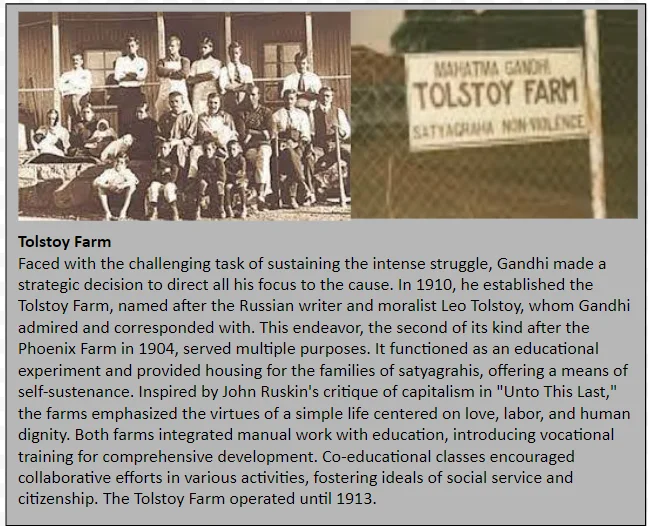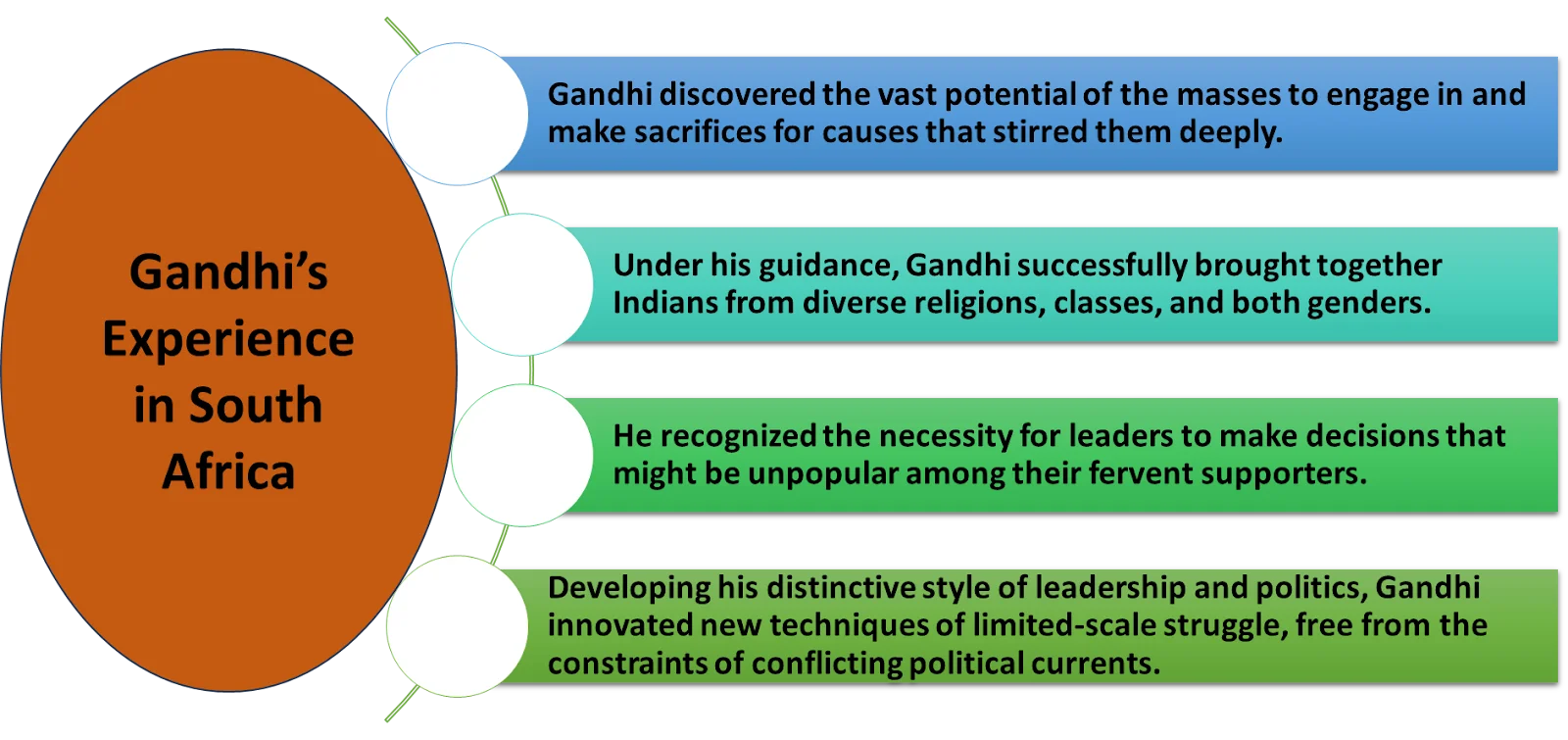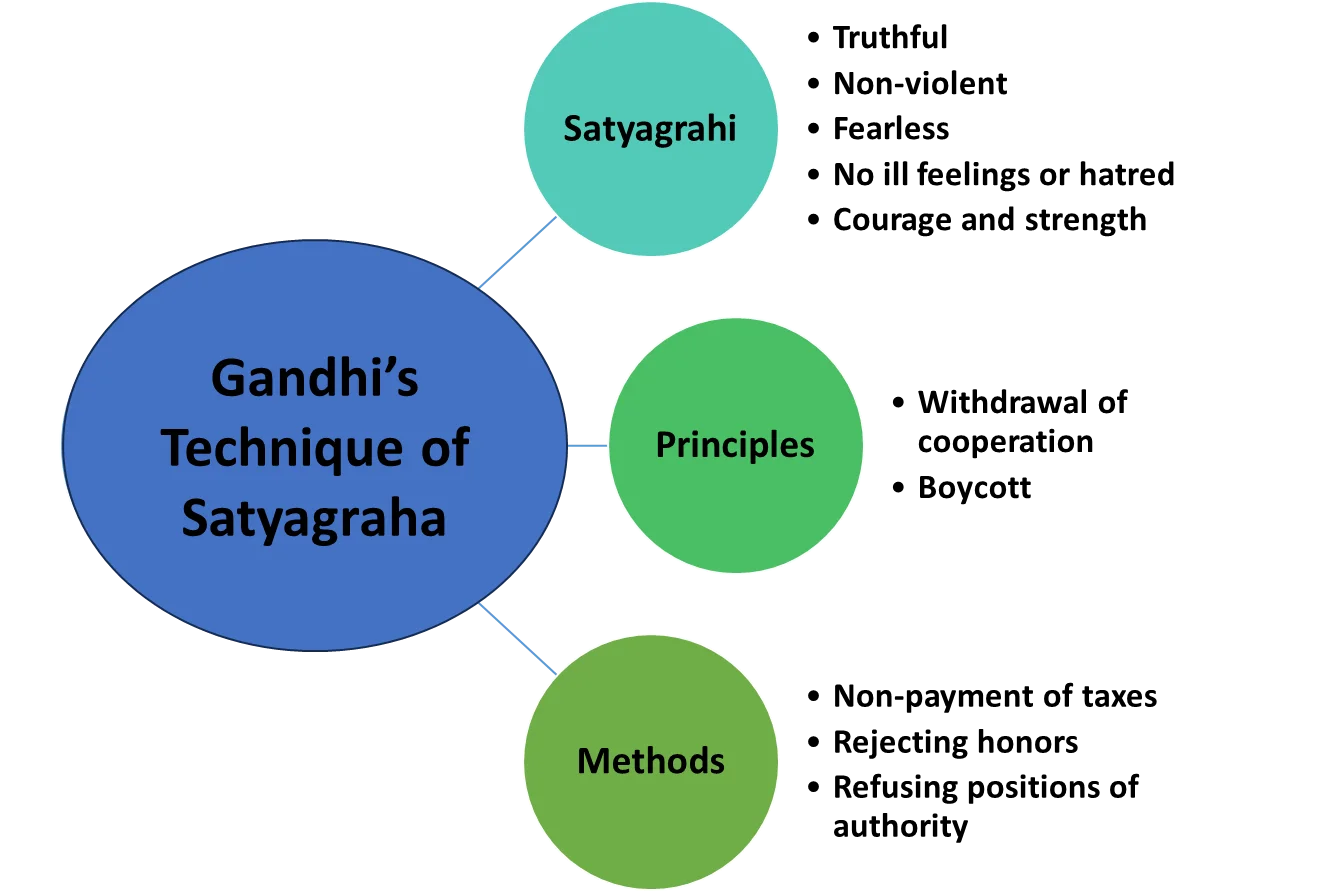Gandhi’s efforts aimed to unite diverse Indian segments and gain publicity for their demands. Establishing the Natal Indian Congress and initiating the newspaper Indian Opinion showcased Gandhi’s organizational, fundraising, journalistic, and propagandist skills. However, by 1906, having exhausted ‘Moderate’ methods, Gandhi grew convinced that a shift in strategy was imperative. The second phase, commencing in 1906, was marked by the adoption of passive resistance or civil disobedience, a method termed satyagraha by Gandhi.

Satyagraha against Registration Certificates (1906)
Introduction of Satyagraha: In response to a discriminatory South African law mandating Indians to carry registration certificates with fingerprints (to carry at all times), Mahatma Gandhi pioneered the concept of passive resistance known as satyagraha.
- Unification of Indian Community: During a massive public gathering on September 11, 1906, at the Empire Theatre in Johannesburg, the Indian community collectively declared their refusal to comply with the discriminatory law and pledged to endure the ensuing consequences.
- Despite the government’s unwavering stance, the resolve of the Indian population remained unyielding.
- Leading the Passive Resistance Association, Gandhi and his followers defied the law, choosing to endure penalties rather than submit. This marked the inception of satyagraha—a nonviolent method of resisting adversaries.
- Impact of Nonviolence: The government’s imprisonment of Gandhi and others ultimately led to a compromise settlement, showcasing the power of nonviolent resistance.
- Campaign against Restrictions on Indian Migration:
- Expanding on the initial campaign, Indians in South Africa protested against a new law imposing restrictions on their migration.
- In response to acts of civil disobedience, many Indians faced imprisonment.
- Back in India, Gopal Krishna Gokhale undertook a nationwide tour, rallying public opinion and drawing attention to the plight of Indians in South Africa. Even Lord Hardinge, the Viceroy, condemned the repressive measures.
- Expanding on the initial campaign, Indians in South Africa protested against a new law imposing restrictions on their migration.
Campaign against Poll Tax and Invalidation of Indian Marriages
- Resistance Against Poll Tax and Marital Restrictions: The resistance movement broadened its scope to protest a three-pound poll tax imposed on ex-indentured Indians.
- Simultaneously, there was opposition to a Supreme Court order invalidating marriages not conducted according to Christian rites.
- Community Outrage Over Marriage Law: The judgment implied that Hindu, Muslim, and Parsi marriages were deemed illegal, rendering children born from these unions illegitimate.
- The Indian community perceived this ruling as a profound insult to the dignity of their women, galvanizing the active participation of many women in the movement in response to this indignity.
Protest against Transvaal Immigration Act
- Gandhiji’s Call for the Ultimate Struggle: Gandhiji made the decisive decision that the time was ripe for the ultimate struggle, consolidating all the resources of the resisters.

- Satyagrahi March: The campaign commenced with a bold move as a group of sixteen Satyagrahis, including Kasturba, Gandhiji’s wife, illegally crossed the border. They marched from Phoenix Settlement in Natal to Transvaal, facing immediate arrest.
- Women’s March to Natal: Subsequently, eleven women from Tolstoy Farm in Transvaal marched across the border into Natal without a permit. They reached New Castle, a mining town, engaging with Indian mine workers, predominantly Tamils.
- Opposition to the Transvaal Immigration Act: Before their arrest, these women successfully persuaded the workers to initiate a strike. Indians vehemently opposed the Transvaal Immigration Act by engaging in illegal migration from Natal to Transvaal.
- The government responded with arrests, and the movement gained momentum with lightning strikes by miners and plantation workers.
Compromise Solution
- Following extensive negotiations involving Gandhi, Lord Hardinge, C.F. Andrews, and General Smuts, a compromise was reached. The Government of South Africa acceded to major Indian demands related to the poll tax, registration certificates, and marriages conducted according to Indian customs.
- Assurances on Indian Immigration: Additionally, assurances were given to address the issue of Indian immigration sympathetically. This marked a significant turning point in the struggle against racial discrimination.
Outcome and Learning of the Movement in South Africa
Gandhian Method: Non-violent civil disobedience achieved its objective in South Africa by compelling opponents to engage in negotiations and accede to the movement’s demands. The success of this strategy laid the groundwork for what would later be termed the ‘Gandhian’ method, ready to be applied on a larger scale in the Indian subcontinent.
| “… a man who cares nothing for sensual pleasure, nothing for riches, nothing for comfort or praise, or promotion, but is simply determined to do what he believes to be right. He is a dangerous and uncomfortable enemy, because his body which you can always conquer gives you so little purchase upon his soul.”
—Gilbert Murray on Gandhi in the Hibbert Journal |
- A crucial lesson Gandhi learned was the dual challenge of leadership—navigating not only the resistance of opponents but also managing dissent from enthusiastic followers.
- South Africa became the testing ground for Gandhi’s evolving political style and innovative struggle techniques. Having transitioned the movement from its ‘Moderate’ phase to its distinctive ‘Gandhian’ phase, he arrived in India in 1915 armed with the conviction that this method was the most effective means of instigating change.
- Collective Ability of Masses: Gandhi’s leadership in South Africa offered a unique opportunity to understand and harness the capacity of the Indian masses for participation and sacrifice. Leading impoverished Indian laborers demonstrated their resilience in the face of repression, this strengthened Gandhi’s conviction in the masses collective ability to champion a cause.
-
- Holistic Approach to Leadership: The South African experience was marked by the unity of Indians from diverse backgrounds—different religions, regions, and social classes.
- This inclusivity, with rich merchants standing alongside poor indentured laborers, laid the foundation for a holistic approach to leadership.
- Holistic Approach to Leadership: The South African experience was marked by the unity of Indians from diverse backgrounds—different religions, regions, and social classes.
Gandhi’s Experience in South Africa

Gandhi’s Technique of Satyagraha
Gandhi crafted the technique of Satyagraha during his South African sojourn, rooted in the principles of truth and non-violence. This approach amalgamated elements from Indian tradition with Christian teachings emphasizing turning the other cheek, and Tolstoy’s philosophy advocating non-violent resistance as the most effective response to evil.

The foundational tenets of Satyagraha included:
- Resistance against wrong: A satyagrahi remains truthful, non-violent, and fearless in resisting what he perceives as wrong.
- Principles: The principles involve withdrawal of cooperation and boycott.
- Methods: Methods encompass non-payment of taxes, rejecting honors, and refusing positions of authority.
- Commitment: A satyagrahi willingly embraces suffering in their struggle for truth, viewing it as an integral part of their commitment.
- Attitude of Satyagrahi: Despite opposing wrongs, a true satyagrahi harbors no ill feelings or hatred toward the wrongdoer. The genuine satyagrahi refuses to yield to evil, regardless of the consequences.
-
- Satyagraha demands courage and strength; it’s not for the weak or cowardly. Violence is preferable to cowardice, emphasizing the inseparability of thought and practice. The ends cannot justify the means.
| Must Read | |
| Current Affairs | Editorial Analysis |
| Upsc Notes | Upsc Blogs |
| NCERT Notes | Free Main Answer Writing |
Conclusion
Gandhi’s South African phase of Satyagraha marked a pivotal evolution in resistance movements. By embracing non-violent civil disobedience, he unified diverse Indian communities and compelled a compromise with the South African government. This experience not only validated the effectiveness of nonviolent protest but also refined Gandhi’s leadership and strategic approach. The success of Satyagraha in South Africa set a precedent for its larger application in India, demonstrating its profound impact on global resistance movements.
Sign up for the PWOnlyIAS Online Course by Physics Wallah and start your journey to IAS success today!
| Related Articles | |
| Indian National Congress | Mahatma Gandhi Biography, Birth, Early Life, Education, Death |
| Supreme Court | Satyagraha |

 GS Foundation
GS Foundation Optional Course
Optional Course Combo Courses
Combo Courses Degree Program
Degree Program









